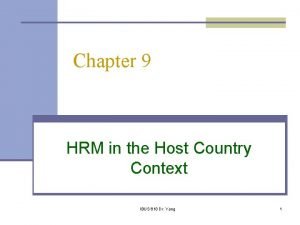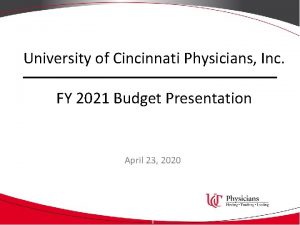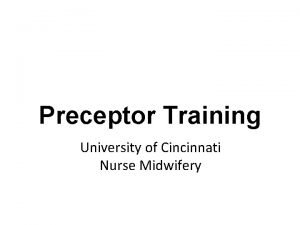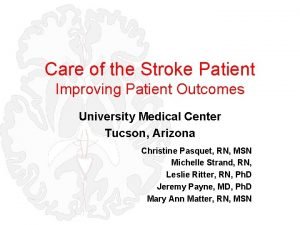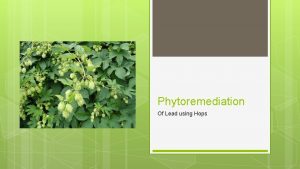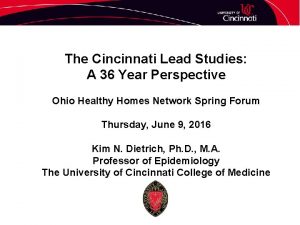Health Consultation Cincinnati Country Day School Lead Site














- Slides: 14

Health Consultation Cincinnati Country Day School Lead Site Cincinnati, OH Ashley Roberts February 9, 2009

Purpose l l This health consultation documents activities taken place to date and makes States recommendations to the school district and United Environmental Protection Agency (U. S. EPA) to reduce and lessen exposure to lead contaminated soils. The Health Assessment Section (HAS) of the Ohio Department of Health (ODH) was asked by the U. S. EPA to evaluate analytical results of soil samples collected from the Cincinnati Day School Located at 6905 Given Road in Cincinnati, Hamilton County, Ohio to decide if the levels of lead detected on the school property posed a public health threat to students, faculty, and visitors of the school and provide recommendations for levels of lead that would be considered safe to be left in the soil.

Background l l l Possibility of lead contamination in soils at the Cincinnati Country Day School (CCDS) discovered in 2003. The Camargo Club performed a survey to decide the size of the drop zone of their skeet shooting range which used lead in the shotgun shells. Results of samples taken show that the area affected may extend onto the school’s softball field and junior high baseball field.

Samples l l Initial soil samples found along school’s fence line in November 2003 confirmed lead contamination. Additional samples collected in December 2003, January and February 2004 equaled a total of 150 soil samples covering 3 -4 acres of school property.

Samples l l l In top 6 inches of soil lead levels ranged from non-detectable levels up to 2, 010 parts per million Highest levels found by fence line between the school and the Carmargo Club and in the outfield of the two ball diamonds ranging from non-detectable up to 56, 000 parts per million in soils deeper than 6 inches. Below 400 parts per million is the safe level of residential exposure established by the U. S. EPA and ODH

Concerns l l l Exposure to lead has largest impact on children under age of six and on pregnant women. Lead’s primary negative impact is on the developing nervous system. Lead exposures have been associated with impaired development and decreased IQ levels in young children.

Concerns l l Children are most at risk to lead exposure from contaminated soils due to their smaller size and tendency to put things in their mouth. During ball games, dust is generated that exposes the players and spectators to lead.

Exposure l l l Students and faculty of the school have to come into physical contact with the lead contaminated soils and be exposed to the contamination for harmful health effects to occur. To come into contact with lead in the environment there must be the development of a completed exposure pathway. Exposure pathways can also be described as to when the exposure happened (past, present, or future)

Completed Exposure Pathway 1) 2) 3) 4) 5) A source of lead in the environment A way for the lead to travel from its source to the soil A place where the residents comes in to contact with the lead A route by which the person comes into contact with the lead (eating, breathing) People who could potentially be exposed

Exposure l l Physical contact with the lead in the environment by itself does not necessarily mean that a person develop harmful would health effects because it is not quickly absorbed by the skin. Other reasons: – – – How much lead a person is exposed to (dose) How long a person is exposed (duration) How often a person is exposed to the lead (frequency) The person’s age The person’s diet and nutritional habits

Exposure l l Most of lead detected in soils on school property appears to be in the grass covered areas – Grass is an effective barrier in limiting exposure to lead Only students and patrons who use those fields have the opportunity to come into contact with the lead contaminated soils (athletes, coaches and any small children that may visit the school for sporting events).

Action Plan l l l Restrict access to the lead contaminated soils that contain levels above 400 ppm. Ensure that the contaminated soils at the school are removed and/or improved and that the remaining soils do not have lead levels above 400 ppm. Camargo Club is performing the cleanup under the supervision of the U. S. EPA.

Action Plan l l HAS is not currently recommending that most of the faculty and students of the CCDS be tested for lead because there is no evidence of a completed exposure pathway to lead at levels that would be expected to cause harmful health effects. If parents have concerns that their child has been exposed to excessive lead they should contact their family physician for information about having a blood lead screening.

Sources l l http: //www. atsdr. cdc. gov/hac/PHA/index. asp Prepared by Health Assessment Section of the Ohio Department of Health Under a Cooperative Agreement with the Agency for Toxic Substances and Disease Registry
 Day 1 day 2 day 3 day 4
Day 1 day 2 day 3 day 4 Day 1 day 2 day 817
Day 1 day 2 day 817 Independent school tuition models
Independent school tuition models Host country and home country
Host country and home country Intra country vs inter country
Intra country vs inter country Hot site cold site warm site disaster recovery
Hot site cold site warm site disaster recovery Frequency dependence of dielectric constant
Frequency dependence of dielectric constant Modern day country
Modern day country University of cincinnati physicians inc
University of cincinnati physicians inc University of cincinnati midwifery
University of cincinnati midwifery Cincinnati stroke scale
Cincinnati stroke scale Cincinnati prehospital stroke scale
Cincinnati prehospital stroke scale Meetup.com cincinnati
Meetup.com cincinnati Southwestern college cincinnati ohio
Southwestern college cincinnati ohio Cincinatti stroke scale
Cincinatti stroke scale



